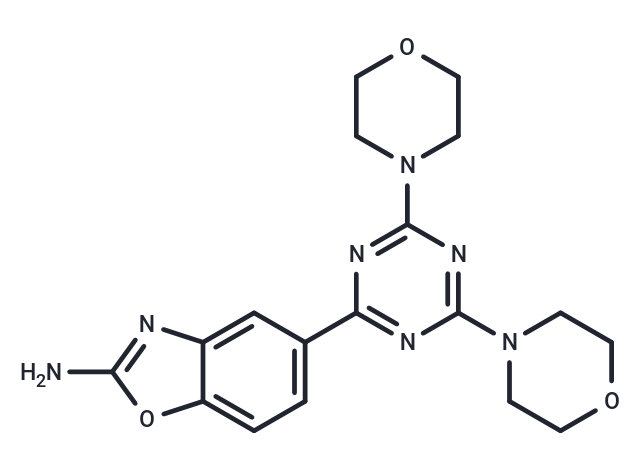Shopping Cart
Remove All Your shopping cart is currently empty
Your shopping cart is currently empty
PI3Kα-IN-9 is an orally available, selective and potent PI3Kα inhibitor with antiproliferative activity, inhibits PI3Kα, PI3Kγ, PI3Kδ, and PI3Kβ, induces apoptosis, and can be used in the study of cancer.

| Pack Size | Price | USA Warehouse | Global Warehouse | Quantity |
|---|---|---|---|---|
| 1 mg | $52 | In Stock | In Stock | |
| 5 mg | $123 | In Stock | In Stock | |
| 10 mg | $198 | In Stock | In Stock | |
| 25 mg | $455 | In Stock | In Stock | |
| 50 mg | $689 | In Stock | In Stock | |
| 100 mg | $1,090 | In Stock | In Stock |
| Description | PI3Kα-IN-9 is an orally available, selective and potent PI3Kα inhibitor with antiproliferative activity, inhibits PI3Kα, PI3Kγ, PI3Kδ, and PI3Kβ, induces apoptosis, and can be used in the study of cancer. |
| Targets&IC50 | PI3Kβ:153 nM, PI3Kγ:128 nM, PI3Kδ:146 nM, PI3Kα:4.4 nM |
| In vitro | PI3Kα-IN-9 (0-2 μM; 72 hours) inhibited the growth of various cancer cells with IC50 values ranging from 0.43 to 1.33 μM. |
| In vivo | In male Sprague-Dawley rats, PI3Kα-IN-9 (1 and 10 mg/kg; oral administration and intravenous injection; for 24 hours) demonstrated favorable pharmacokinetic parameters in vivo[1]. |
| Molecular Weight | 383.4 |
| Formula | C18H21N7O3 |
| Cas No. | 2715287-67-3 |
| Smiles | N1=C(N=C(N=C1N2CCOCC2)N3CCOCC3)C4=CC=C5OC(=NC5=C4)N |
| Color | Red |
| Appearance | Solid |
| Storage | Powder: -20°C for 3 years | In solvent: -80°C for 1 year | Shipping with blue ice/Shipping at ambient temperature. | |||||||||||||||||||||||||||||||||||
| Solubility Information | DMSO: 80 mg/mL (208.66 mM), Sonication is recommended. | |||||||||||||||||||||||||||||||||||
| In Vivo Formulation | 10% DMSO+40% PEG300+5% Tween 80+45% Saline: 3.3 mg/mL (8.61 mM), Sonication is recommended. Please add the solvents sequentially, clarifying the solution as much as possible before adding the next one. Dissolve by heating and/or sonication if necessary. Working solution is recommended to be prepared and used immediately. The formulation provided above is for reference purposes only. In vivo formulations may vary and should be modified based on specific experimental conditions. | |||||||||||||||||||||||||||||||||||
Solution Preparation Table | ||||||||||||||||||||||||||||||||||||
DMSO
| ||||||||||||||||||||||||||||||||||||
| Size | Quantity | Unit Price | Amount | Operation |
|---|

Copyright © 2015-2025 TargetMol Chemicals Inc. All Rights Reserved.